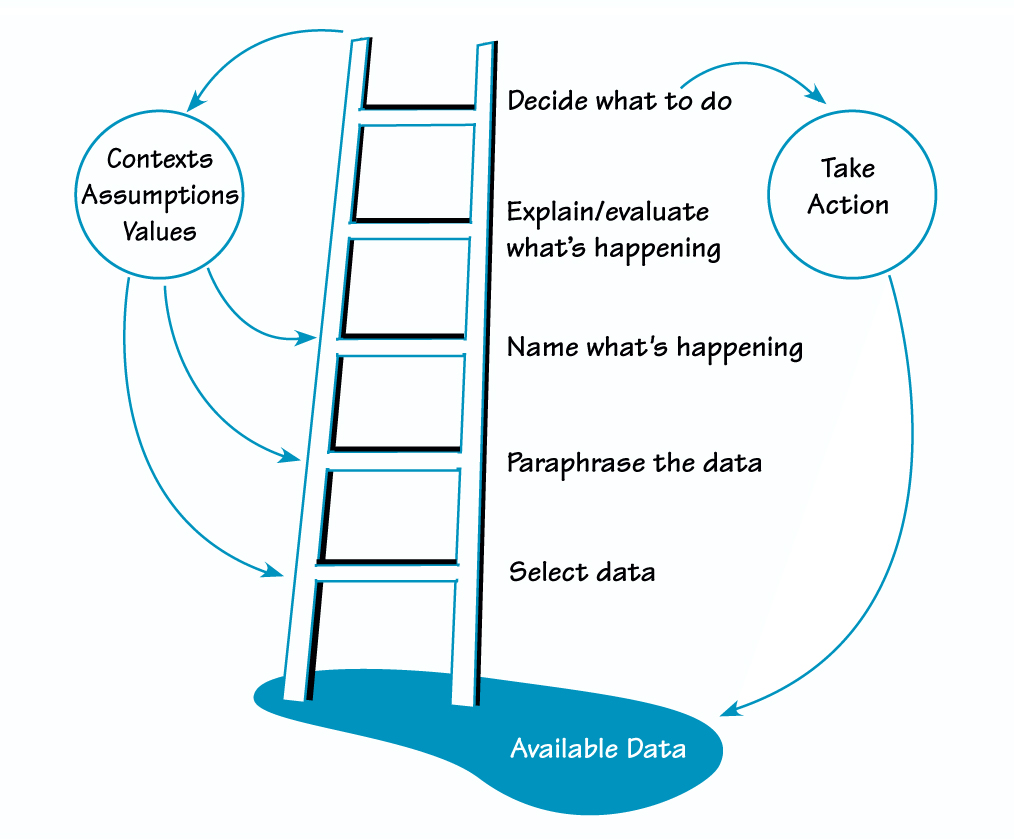Every day, our minds are busy processing tons of information, mostly subconsciously. One of the ways we make sense of our experiences is through a series of mental steps referred to as the "Ladder of Inference." This mental model, first proposed by Chris Argyris, a Harvard Business School professor, provides a lens to understand how we perceive situations, draw conclusions, and take action. Understanding this process allows us to check our assumptions, improve our decision-making, and foster a more inclusive and welcoming environment.
The Ladder of Inference
The Ladder of Inference describes a common mental pathway of increasing abstraction, often leading to misguided beliefs or actions. It consists of seven steps, each leading further away from objective facts and closer to subjective interpretations:
- Observable Data and Experiences: We encounter raw data and experiences daily.
- Selected Data: Our mind, unable to process everything at once, selectively chooses specific data points.
- Added Meanings: We interpret these data points based on our personal experiences and biases, attributing their meanings.
- Assumptions: We make assumptions based on the interpreted meanings.
- Conclusions: We conclude these assumptions.
- Beliefs: These conclusions solidify into beliefs over time.
- Actions: Finally, our beliefs influence our actions.
Without realizing it, we tend to climb this ladder quickly, creating a cycle of self-reinforcing thoughts and actions. However, recognizing this process allows us to pause and critically evaluate our assumptions and actions, thus minimizing misunderstandings or conflicts.
Checking Our Assumptions
To climb down the Ladder of Inference, we must challenge our assumptions. Ask yourself:
- What information have I selected, and what have I overlooked?
- What meanings have I attributed to these data points?
- What assumptions have I made?
- Are my conclusions logical?
- Are my beliefs influencing my actions unfairly?
These questions can help break down your thought process and make it more transparent to others. This, in turn, can encourage open dialogue and foster mutual understanding.
Creating Inclusive and Welcoming Environments
The Ladder of Inference can be an invaluable tool for creating a more inclusive and welcoming environment. Here's how:
- Raise Awareness: Make people aware of the Ladder of Inference model. By understanding it, they can better recognize their own cognitive processes and appreciate others' perspectives.
- Promote Self-reflection: Encourage individuals to reflect on their assumptions and biases. This can help them make more informed and empathetic decisions.
- Foster Open Dialogue: Encourage the sharing of thought processes, assumptions, and beliefs. This can lead to mutual understanding and respect, reducing conflicts and misunderstandings.
- Facilitate Feedback: Create a culture where feedback is welcomed and used for growth. This can help individuals understand the impacts of their assumptions and actions on others.
- Commit to Learning: Encourage a learning culture where assumptions and beliefs can be challenged and evolved. This promotes a growth mindset and inclusivity.
Climbing the Ladder of Inference is a natural human process. But by understanding this mental model, we can start to question our assumptions and beliefs and ultimately create more inclusive and welcoming environments. So the next time you rush to conclusions, remember to step back, climb down the ladder, and check your assumptions. Because, at the end of the day, our actions, driven by our thoughts and beliefs, can make a significant difference.
Resources








